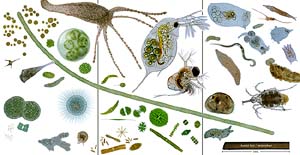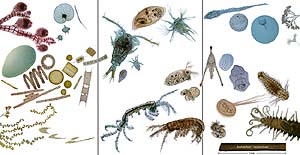of Microorganisms
Making an art work for the Natuurmuseum Rotterdam
by Wim van Egmond, The Netherlands

Freshwater side: The transparencies are transferred to the windows
|
of Microorganisms Making an art work for the Natuurmuseum Rotterdam by Wim van Egmond, The Netherlands |

Freshwater side: The transparencies are transferred to the windows |
|
| Recently I was asked by the Natuurmuseum in Rotterdam if I could make a work of art for them. They already knew that I portrayed microorganisms. If I could make something with microorganisms it would fit in the new permanent exhibition of the museum about the diversity of life. |
| The
location of the art work would be a 4,5 meter glass corridor that connected
the old classic building of the museum with the new, modern building. The
piece should fit within a theme of bio-diversity The exhibit shows the
variety of life in the form of prepared animals. Because it is not so easy
to show microorganisms they thought of asking me if I could make something
in the form of a big group portrait.
I decided to show most major lifeforms found in freshwater as well as in marine water. The windows facing to the west have all kinds of creatures from the North sea (the Netherlands lie east of the North Sea). The fresh water organisms are located on the windows on the east side. |

|

|
||
| Technique
Since the organisms would have to be placed on the glass windows we agreed that they should be printed as big transparencies. Because most microorganisms are very transparent this would also resemble their actual appearance. I started trying to photograph as many types of organisms as possible. I used mainly brightfield illumination. I scanned the slides and with the computer I made the backgrounds white. By making a soft selection around the edges of the organisms they don't look too much like cut outs. This was especially a lot of work with the spiny forms, the arthropods with the many appendages. Then the most difficult part of the project came. Finding a printing technique to create transparencies on adhesive material. It took a lot of effort to get this done. I was lucky to find a very helpful professional. With the help and persistence of Henk Deege, I succeeded in finding a good technique but it took us months of testing. The final digital images were a total of 1.2 gigabytes. The printing area was 1,23 m by 10m, with all the microorganisms fitted together like a jigsaw puzzle. We had to pass many obstacles. A window cracked just before we were going to finish the project. After the window was replaced we discovered that the company that would do the printing changed their machine for another machine, so I had to resize and 'repuzzle' all the computer files. |
Scale
1000 to 1
I decided a scale of a thousand to one would result in microorganisms of considerable size. To give an extra clue to the scale I photographed a human hair. A piece 1 millimeter long becomes 1 meter! This way it would be easy to get a good idea of the actual size of the creatures. One of the problems I had to solve was the different sizes of the organisms! I had to use different lenses on the microscope so there was the risk that the smaller creatures would show more detail. To get a good resolution of the bigger creatures compared to the smaller I made montages. The waterflea was made from 3 pictures combined to create a very high resolution image. The hydra is perhaps a bit small but I used a young hydra. A full grown hydra would be ten meters, this one is only two. The filamentous algae Spirogyra is more than 4 meters long. The final composition may look a bit wild, but what can you expect from a bunch of microbes. I did try to bring some kind of organisation into the final composition. The fresh water organisms are grouped around a long Spirogyra. Related organisms are grouped together. There is also a distinction between single celled life forms (below Spirogyra) and the colonial and multicellular organisms (above Spirogyra). For the marine portrait I created a wavelike composition. I used the 3 windows to make a distinction between plantlike organisms, arthropods and other groups. |
||
| If
you ever get a chance to visit The Netherlands it would be an idea to go
to the Natuurmuseum. Although the city
of Rotterdam is a big industrial city it could be worth a visit. The Natuurmuseum
is a small but very delicate museum that it is located in an area with
many major museums. Rotterdam is also renowned for its modern architecture.
Note: I must admit that I'm from Rotterdam myself so I am not sure if you should trust me on my word. |
All comments to the author Wim van Egmond are welcomed.
Visit Wims home page for links to his many web pages on microscopy
Please report any Web problems or
offer general comments to the Micscape
Editor,
via the contact on current Micscape
Index.
Micscape is the on-line monthly magazine
of the Microscopy UK web
site at Microscopy-UK